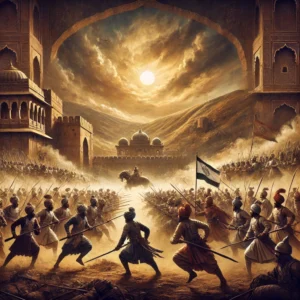
Egerp Panipat is a significant term that may refer to various historical contexts linked to the famous battles and events that took place in Panipat, India. This location is known for its pivotal role in shaping the political landscape of India, particularly during the 18th century. The battles of Panipat mark critical turning points that hold relevance even today.
Many are intrigued by the rich history and the socio-political factors surrounding these events. Readers will find that understanding Egerp Panipat not only opens doors to India’s past but also reveals lessons that resonate with contemporary issues. The narrative surrounding Panipat unravels themes of strategy, resilience, and change.
Through an exploration of Egerp Panipat, one uncovers the complexities of warfare, leadership, and the quest for power. They will discover key figures, strategies, and consequences that defined eras and shaped modern India.
History of the Battle of Panipat
The Battle of Panipat holds significant historical importance in Indian history, particularly in the context of the Mughal Empire and regional power struggles. It was a decisive conflict that shaped the political landscape and influenced future governance.
Background and Causes
The roots of the Battle of Panipat are deeply embedded in the power vacuum created by the decline of the Mughal Empire in the early 18th century. Regional powers such as the Marathas, Sikhs, and Afghans sought to expand their territories amidst this instability.
The most immediate cause was the ambition of Ahmad Shah Durrani, who aimed to reclaim his lost territories in India. The Marathas, under the leadership of SadashivraoBhau, were poised to assert dominance in northern India. Tensions escalated as both factions sought control over the lucrative trade routes and strategic areas, ultimately leading to conflict.
Combatants and Leaders
The battle drew two main factions: the Maratha Empire and the Durrani Empire. Ahmad Shah Durrani, also known as Ahmad Shah Abdali, led the Afghan forces. He was a formidable strategist with a capable military, aiming to revive his influence in India.
On the other side, the Marathas were led by SadashivraoBhau, a commander known for his bold tactics. The Maratha force comprised infantry, cavalry, and artillery, reflecting their military evolution. Key figures, including less prominent leaders, also played crucial roles, influencing battle decisions and troop morale.
Major Battle Events
The battle took place on January 14, 1761, near Panipat, present-day Haryana. The Afghan army initially held superior numbers and employed effective cavalry tactics. The Marathas, however, undertook strategic formations and attempted to outmaneuver their opponents.
Throughout the day, intense fighting ensued, characterized by brutal hand-to-hand combat. As the battle progressed, the Maratha forces faced logistical issues, leading to significant troop losses. Despite their bravery, the Marathas succumbed to the tactical prowess of the Afghan army, culminating in a decisive victory for Ahmad Shah Durrani.
Outcomes and Consequences
The Battle of Panipat drastically altered the political dynamics in India. The defeat severely weakened the Maratha Empire, leading to internal strife and fragmentation. It also marked the end of an era of Maratha supremacy in northern India.
Ahmad Shah Durrani’s victory established his influence temporarily, but it was short-lived due to subsequent invasions and internal challenges. The battle also inflicted massive casualties, with estimates suggesting up to 100,000 soldiers lost. This battle is often seen as a significant turning point that paved the way for British colonial expansion in the 19th century.
Egerp Panipat’s Significance
Egerp Panipat plays a crucial role in various domains including politics, culture, and economics. Its influence is felt across these areas, shaping narratives and impacting communities.
Political Implications
Egerp Panipat has significant political implications within its region. It serves as a strategic location for political gatherings and negotiations. Historical battles fought near Panipat highlight its importance as a site of power struggles.
These events have shaped governance and territorial boundaries in the area. The legacy of leadership and military strategy associated with Panipat continues to influence contemporary political thought.
Local governance also often reflects the historical narratives tied to Egerp Panipat, impacting how citizens engage with political processes. The intertwining of history and politics adds weight to decisions made by local authorities.
Cultural Impact
The cultural impact of Egerp Panipat is deeply rooted in its history. Art, literature, and folklore often draw inspiration from the events that transpired in this region. The stories of battles, heroism, and sacrifice resonate strongly within local traditions.
Various festivals celebrate this heritage, fostering a sense of identity among residents. These cultural expressions not only preserve history but also attract tourism, helping to sustain local traditions.
Moreover, educational institutions in the area emphasize the importance of Panipat in Indian history, ensuring that new generations understand its cultural significance. The narrative of Egerp Panipat is thus interwoven into the fabric of regional identity.
Economic Effects
Economically, Egerp Panipat has implications for trade and commerce. Its strategic location has historically facilitated trade routes, contributing to the prosperity of local markets. Access to resources and transportation networks enhances economic opportunities.
Agriculture thrives in surrounding areas, benefiting from historical irrigation techniques that date back to early civilizations. This agricultural strength supports not only local economies but also broader supply chains.
Furthermore, the tourism industry capitalizes on Egerp Panipat’s rich history, creating jobs and boosting local businesses. The economic activities stemming from this significance foster growth and development within the community.
Vaishno Devi VIP Darshan Ticket Price: An Overview for Pilgrims
When planning a pilgrimage to Vaishno Devi, many visitors seek information on the VIP dars…